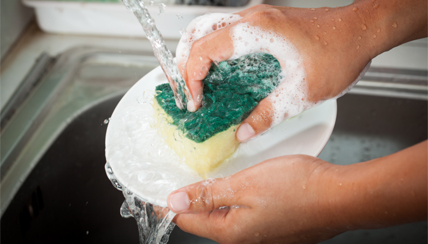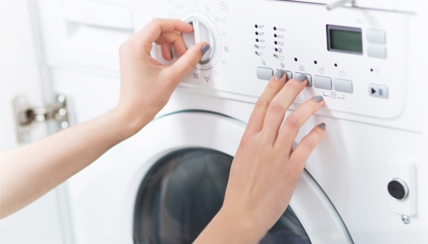Cleaning Dirty Items
Gross Facts and Cleaning Suggestions
Kitchen Sponge and Dishcloth
Gross: Dishcloths and sponges contain the largest amount of E. coli in the average home because they aren’t replaced often.
 Clean: Wash dishcloths weekly in the washing machine. Clean sponges in the dishwasher, or heat wet sponges in the microwave for 60 seconds.
Clean: Wash dishcloths weekly in the washing machine. Clean sponges in the dishwasher, or heat wet sponges in the microwave for 60 seconds.
Purses and Handbags
Gross: Researchers found that the average purse or handbag is three times dirtier than an office toilet seat. Purse handles carry the most bacteria, but hand and face creams, and lip products were dirty too.
Clean: Keep your purse and other bags off the floor in bathrooms. Wash cloth bags regularly in the washing machine and use disinfectant wipes wash to clean plastic or leather bags.
Kitchen Faucet Handles
Gross: Your kitchen faucet handles can have twice the number of bacteria as bathroom faucet handles.
Clean: Use a disinfecting cleaner daily to disinfect and clean the handles and entire sink.
Washing Machine
 Gross: Clothes and towels can spread germs when they are used by more than one person, when the person handling the dirty laundry doesn’t wash his or her hands, and if not washed properly. Underwear can have over 100 million E. coli bacteria, a cause of diarrhea.
Gross: Clothes and towels can spread germs when they are used by more than one person, when the person handling the dirty laundry doesn’t wash his or her hands, and if not washed properly. Underwear can have over 100 million E. coli bacteria, a cause of diarrhea.
Clean: Wash clothing worn by a person who has an infectious illness, used in food preparation and health care work, and those with sweat, vomit, blood and feces separate from other items and at a high temperature with a bleach-based detergent. Disinfect your machine by pouring two cups of bleach into the detergent compartment and run empty on the hottest water cycle, then wipe dry.
Cutting Board
Gross: Raw meat can add 200 times more fecal matter than on a toilet set onto a cutting board.
Clean: Wash plastic and dishwasher-safe cutting boards in the dishwasher using hot water, or wash with liquid dish detergent and water, then soak thoroughly in a solution of two teaspoons bleach and 1 gallon of water. Wash wooden boards with dish detergent and water, and soak in two tablespoons of bleach per gallon of water, but don’t soak overnight. Remember to use separate cutting boards and utensils for raw meat and other foods. Replace cutting boards that are worn or have hard-to-clean grooves.
Pet Food Dish
Gross: A dog can pick up over 2,000 bacteria per square inch from his unclean dish.
Clean: Just as you wash your dishes every day, wash all pet food bowls after every meal with hot water and soap to prevent bacteria from building up.
Electronic Devices – computer keyboard, smart phone, tablet computer
Gross: Studies show that 92 percent of cell phones have bacteria on them. Bacteria thrives on the warm screen and can be transferred to fingers, eyes, nose, ears, lips and skin. This increases your chance of getting infected.
Clean: Don’t use a disinfectant wipe as it can damage the screen. Fill a small spray bottle half with water and the other half with 70 percent isopropyl alcohol. Lightly spray this solution on a soft cloth to clean your device weekly, and leave it out of the bathroom.
Light Switch
Gross: A bathroom light switch can have as many germs as a trash can.
Clean: Use a disinfecting spray or wipe, ideally a new one for each item cleaned.
Carpet
Gross: Carpet collects food particles, pet dander, pollen and other items as well as about 1.5 million dead cells per person per hour. That means your carpet has nearly 700 times more bacteria than your toilet seat.
Clean: Vacuum often and once a year, have a professional cleaning service deep clean your carpet.
Money/Credit Cards
Gross: One in every 12 bank cards and one in seven dollar bills are contaminated with fecal matter.
Clean: Wipe your credit cards with a disinfecting wipe after using them. Wash your hands or use alcohol-based hand sanitizer after handling money.
Remember to Clean Your Hands!
You can get sick from getting germs on your hands and then touching your eyes, nose or mouth. One of the best ways to protect yourself from serious infections is to clean your hands frequently and thoroughly.
Watch Good Health and Hand Washing
No transcript available. No speech detected.
This information has been reviewed and approved by LeeAnn Bryant, BSN, MHS, RN (November 2016)
